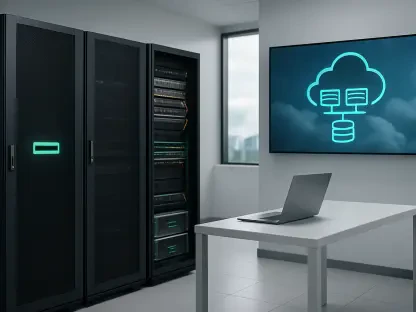In an era where digital transformation dictates the pace of innovation, data centers stand as the unsung heroes powering the technologies that shape modern life, from artificial intelligence to cloud computing. These vast facilities, filled with servers and storage systems, are the critical infrastructure behind artificial intelligence (AI) and cloud computing—two pillars of the current technological revolution. From enabling complex AI algorithms to supporting the seamless storage and retrieval of enterprise data, data centers are indispensable to industries and individuals alike. However, their rapid proliferation to meet escalating demand has unveiled a significant challenge: an enormous appetite for energy. This surge in electricity consumption places unprecedented strain on global power resources, raising questions about sustainability in a world striving for net-zero emissions. The balancing act between technological advancement and environmental responsibility is becoming increasingly delicate. This article delves into the remarkable expansion of data centers, fueled by AI and cloud computing, while examining the pressing energy hurdles they face. It also explores how major technology companies are addressing these issues, the localized pressures on energy grids, and the promising investment avenues emerging from this complex landscape. As digital needs grow, understanding the interplay between innovation and energy becomes essential for stakeholders across sectors.
Explosive Growth in Digital Infrastructure
The expansion of data centers over recent years paints a picture of unrelenting demand for digital capacity. Global power capacity for these facilities has surged from modest levels a decade ago to an impressive 81 gigawatts (GW) in 2024, marking a staggering 211% increase with a compound annual growth rate of 13%. This growth is a direct response to the rising need for computational resources to support everything from streaming platforms to smart infrastructure. Projections indicate that this trajectory is far from slowing, with capacity expected to reach 222 GW by 2030. Such figures highlight the pivotal role data centers play in the digital economy, acting as the backbone for technologies that are now integral to daily operations across industries. Yet, this rapid scaling brings with it a critical concern: how to power these energy-intensive hubs without compromising global sustainability goals.
Beyond sheer numbers, the growth of data centers reflects broader trends in technological adoption. As businesses and consumers alike embrace digital solutions, the infrastructure required to support these advancements must keep pace. This isn’t merely about building more facilities; it’s about ensuring they can handle increasingly complex workloads. The push for higher capacity is driven by the expectation that digital dependency will only deepen in the coming years, with innovations continuing to demand more robust systems. However, the energy implications of this expansion are profound, as each new facility or upgrade adds to an already substantial electricity footprint. Balancing this growth with environmental considerations remains a formidable challenge for industry leaders and policymakers alike.
AI’s Insatiable Power Demands
Artificial intelligence, particularly the generative kind, has emerged as a dominant force driving the energy needs of data centers. The computational power required to train sophisticated models, such as OpenAI’s GPT-4, consumes nearly 50 times more electricity than earlier iterations like GPT-3. This dramatic increase is largely attributed to advanced graphics processing units (GPUs), with newer models like NVIDIA’s #00 and B200 pushing consumption to even higher levels. The intensity of these workloads places data centers under immense pressure to maintain performance without faltering, as AI applications become more embedded in sectors ranging from healthcare to entertainment. The energy challenge here is not just a matter of scale but of urgency, as the pace of AI adoption shows no signs of abating.
Moreover, the rapid integration of AI technologies amplifies the strain on power resources far beyond initial expectations. As companies race to leverage AI for competitive advantage, the deployment of energy-intensive hardware accelerates, often outstripping advancements in energy-saving measures. This creates a cycle where innovation fuels demand, which in turn necessitates more power. Unlike other technological shifts that allowed for gradual infrastructure adjustments, AI’s swift uptake—especially in tech-forward regions like the United States—has caught many energy systems off guard. Addressing this escalating need requires not only technological ingenuity but also strategic planning to ensure that power supply can match the relentless growth of AI-driven operations.
Cloud Computing as a Persistent Force
While AI garners attention for its dramatic energy spikes, cloud computing remains a steadfast contributor to data center growth. Currently, over half of enterprise workloads and data are hosted in the public cloud, reflecting a profound shift in how businesses manage their IT needs. From data storage to complex analytics, cloud platforms provide scalable solutions that are now fundamental to corporate strategy. This migration is expected to continue, ensuring a consistent and long-term rise in the energy demands placed on data centers. The reliability and flexibility of cloud services make them a cornerstone of modern business, but they also cement the need for robust energy solutions to sustain them.
The steady nature of cloud computing’s demand distinguishes it from the erratic surges associated with AI. This predictability offers some respite for planning, yet it also means that the baseline energy requirements for data centers remain high, even without considering AI’s peaks. As more organizations transition to cloud-based systems, the cumulative effect on power consumption becomes increasingly significant. This trend underscores the necessity for data center operators to prioritize energy management as a core component of their operations. Without proactive measures, the sustained growth driven by cloud adoption could exacerbate existing strains on power grids, particularly in regions already grappling with high digital infrastructure density.
Efficiency Gains Battling Rising Usage
Efforts to curb energy consumption in data centers have yielded notable improvements in efficiency over the years. Metrics like power usage effectiveness (PUE) ratios have improved, reflecting more efficient use of electricity. Innovations such as Google’s Tensor Processing Units (TPUs) and advanced cooling technologies have also played a role in reducing the energy required per unit of computation. These advancements are critical, as they help lower operational costs and make digital infrastructure more accessible to a wider range of users. At first glance, such progress suggests a path toward mitigating the environmental impact of data centers.
However, a paradoxical effect undermines these efficiency gains. As technologies become more energy-efficient, they often become cheaper and more widely adopted, leading to a net increase in overall usage. The rapid proliferation of generative AI, for instance, illustrates this phenomenon—its accessibility has driven exponential growth in deployment compared to earlier digital revolutions like the internet. Consequently, total electricity demand continues to rise, overshadowing the benefits of per-unit reductions. This dynamic reveals a critical insight: technological efficiency alone cannot address the energy challenge. It must be paired with broader strategies to manage consumption and source power sustainably, lest the cycle of innovation and increased demand perpetuate an unsustainable energy burden.
Localized Energy Burdens and Grid Stress
The energy impact of data centers varies significantly across regions, creating uneven challenges for power infrastructure. On a global scale, these facilities account for about 4% of electricity demand growth over the past decade. However, in the United States, they represent 4% of total consumption across 44 states, with certain areas bearing a far heavier load. In Virginia, for example, data centers consume nearly 30% of the state’s electricity, placing extraordinary stress on local grids. Such disparities highlight how the global phenomenon of digital expansion translates into highly localized energy crises, often in areas with dense concentrations of tech infrastructure.
These regional pressures expose vulnerabilities in existing power systems that were not designed to handle such concentrated demand. In high-impact areas, grid infrastructure struggles to keep up, risking outages and reliability issues that could disrupt critical digital services. Addressing this requires targeted investments in grid modernization to enhance capacity and resilience. Without such upgrades, the risk of bottlenecks grows, potentially stalling the very technological progress data centers enable. The situation serves as a reminder that while data centers are a worldwide necessity, their energy challenges often demand localized solutions tailored to the unique constraints and capabilities of specific regions.
Sustainability Efforts by Tech Titans
Major technology companies, often referred to as hyperscalers, are at the forefront of tackling the energy challenges posed by data centers. Firms like Google, Microsoft, and Amazon have become the largest corporate purchasers of renewable energy, contracting over 110 gigawatts (GW) of capacity through power purchase agreements—an amount comparable to the entire power generation capacity of a country like the UK. This commitment reflects a broader push to align with net-zero emission targets while sustaining the massive energy needs of their sprawling digital networks. Their leadership in this space sets a benchmark for the industry, demonstrating that sustainability and growth can be pursued simultaneously.
Yet, the reliance on renewable sources like wind and solar introduces complexities due to their intermittent nature. Data centers require uninterrupted power, a need that renewables alone cannot always meet. This has prompted hyperscalers to explore a diverse array of energy solutions, including small modular reactors (SMRs) for nuclear power, natural gas with carbon offsets, and advanced storage technologies like lithium-ion batteries. These alternatives aim to ensure reliability while maintaining environmental commitments. The multifaceted approach underscores the reality that achieving sustainable power for data centers is not a one-size-fits-all endeavor but a complex puzzle requiring innovation across energy sectors.
Charting a Path Through Energy Dilemmas
Reflecting on the journey of data centers, their rise as indispensable pillars of AI and cloud computing has been marked by extraordinary growth in capacity and capability. The energy demands, intensified by AI’s computational needs and cloud computing’s steady expansion, have placed immense pressure on power systems worldwide. Efforts to improve efficiency were notable, yet they often fueled greater adoption, perpetuating a cycle of risingoyant consumption. Regional disparities in energy impact further complicated the landscape, with certain areas facing disproportionate grid stress. Meanwhile, hyperscalers took bold steps toward sustainability, investing heavily in renewables while grappling with the limitations of intermittent power sources.
Looking ahead, the path forward hinges on strategic actions to address these energy challenges. Prioritizing grid modernization in high-demand regions can alleviate localized strains, ensuring reliability as digital dependency grows. Investment in diverse energy solutions, from nuclear to advanced storage, offers a way to balance sustainability with the constant power needs of data centers. Collaboration between tech companies, energy providers, and policymakers will be crucial to scale renewable capacity and integrate it effectively. For investors, the evolving landscape presents opportunities in utility-scale renewables and smart grid technologies. By focusing on these actionable steps, the industry can navigate the energy dilemmas of today while building a resilient foundation for tomorrow’s digital innovations.









